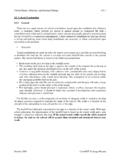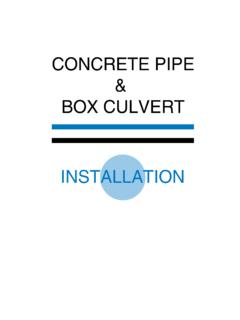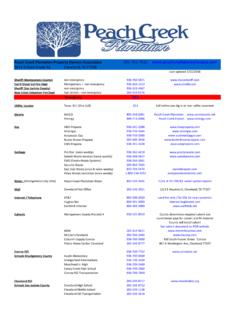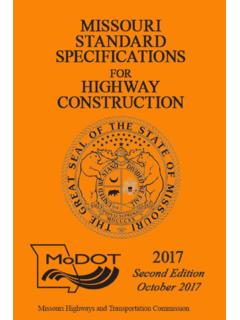Transcription of 4.4 Culvert Materials 4.4.1 General - Connecticut
1 Culvert repair , Materials , and Structural Design 2000 ConnDOT Drainage Culvert are primarily made with reinforced concrete, corrugated metal, and more recently, solid-wall, profile wall, and reinforced plastic. The strength and physical characteristics of the materialsdepend upon their chemistry and the interrelationship between the constituent Materials . Metals andplastic are homogeneous isotropic Materials whereas concrete and masonry is a mixture orcombination of Materials . The method by which the Materials are connected significantlyinfluences whether the strength of the Materials may be utilized may be made with either precast or cast-in-place reinforced concrete. This selectiondepends on the size and complexity of the Culvert design. Precast sections are uniform in size andshape and are made in sections that can easily be transported, lifted, and installed.
2 Cast-in-placeconcrete construction is often used when ready-mix concrete is available and when the culvertshould be constructed without joints. Precast concrete culverts may be made with high strengthconcrete, whereas cast-in-place concrete culverts may have special reinforcement at criticallocations to resist high loads and stresses. Precast Precast concrete pipe is manufactured in eight standard shapes: circular, arch,horizontal elliptical, vertical elliptical, pipe arch, box sections, three-sided arch top, and flat topsections, as shown in Table 4-1. With the exception of box culverts, concrete Culvert pipe ismanufactured in up to five standard strength classifications. The higher the classification numberthe higher the strength. Box culverts are designed for various depths of cover and live loads.
3 All ofthe standard shapes are manufactured in a wide range of sizes. Circular and elliptical pipes areavailable with standard sizes as large as 3600 mm (144 inches) in diameter, with larger sizesavailable as special designs. Standard box sections are also available with spans as large as 3600mm (144 inches). Precast concrete arches on cast-in-place footings are available with spans up m (40 feet). Cast-in-place Reinforced culverts that are cast-in-place are typically either rectangular orarch-shaped. the rectangular or box shape is more common and is usually constructed with multiplecells (barrels) to accommodate longer spans. One advantage of cast-in-place construction is that theculvert can be designed to meet the specific requirements of a site. Due to the longer constructiontime of cast-in-place culverts, precast concrete or corrugated metal culverts are often , in many areas cast-in-place culverts may be more practical.
4 Shapes By the very nature of it, reinforced concrete may be used to make virtually anystructural shape desired. Thus, if necessary and feasible, it is possible to make almost any shapedculvert with either precast or cast-in-place reinforced Culvert repair , Materials , and Structural DesignConnDOT Drainage ManualOctober 2000 Table 4-1 Standard concrete pipe shapes300 to 400mm (12 to 180 in)reinforced100 to 900mm (4 to36 in)non-reinforced375 to 3300 mm(15 to 132 in)equivalent diameterSpan X Rise450 to 3600 mm(18 to 144 in)equivalent diameterSpan X Rise900 to 3600 mm(36 to 144 in)equivalent to m (3 to 12 ft) to m (24 to 41 ft) to m (14 to 35 ft) to m (16 to 36 ft) Culvert repair , Materials , and Structural Design 2000 ConnDOT Drainage SteelCorrugated steel culverts are made with factory-produced corrugated sheet steel.
5 Corrugatedpipe culverts are made with factory-produced corrugated pipe sections. Large corrugated culvertsare normally field-assembled using structural plate products. Structural plate steel products areavailable as structural plate pipes, box culverts, or long span structures. Standard shapes forcorrugated steel culverts are shown on Table 4-2. material Corrugated steel pipe is fabricated from sheets coated with zinc or aluminum. It isreasonably lightweight for shipping and comes in a large range of thicknesses and corrugations toprovide the appropriate strength. However, it requires controlled backfill for proper soil options include various coatings and/or pavings for added protection. Shapes Corrugated steel may be used for a wide variety of shapes, sizes, and lengths ofculverts. The culverts may be made from prefabricated sections that are factory produced orassembled in the field from specially fabricated plates.
6 The shapes may be made from variousthicknesses of plate Corrugated steel pipe is factory made in two basic shapes: round and pipe arch. Bothround and arch shapes are available in a wide range of standard sizes. Round pipe is available instandard sizes up to 3600 mm (144 inches) in diameter. Standard sizes for pipe arch areavailable in sizes up to the equivalent of 3000 mm (120 inch) diameter round pipe. Both shapesare produced in several wall thicknesses, several corrugation sizes, as shown in Figure 4-10 andwith annular (circumferential) or helical (spiral) with annular corrugations have riveted, spot welded, or bolted seams. Pipes with helicalcorrugations have continuously welded seams or lock seams. Corrugated steel pipe and pipe archare usually coated with zinc (galvanized) or aluminum. Additional protective coatings are used withthe metallic coating when there are potential corrosion or abrasion plate Structural plate steel pipes are field assembled from standard corrugatedgalvanized steel plates.
7 Standard plates have corrugations with a 150mm (6-inch) pitch and a depthof 50 mm (2 inches). Plates are manufactured in a variety of thicknesses and are pre-curved for thesize and shape of the structure to be erected. Standard plates have a nominal length of either 3 m (10 or 12 feet) and are produced in standard widths of 3N, 5N, 6N, 7N, and 8N, where Nequals 3 pi or 244 mm ( inches). Widths are measured along the circumference of the the circumference of a circle equals pi times the diameter, the use of dimensions expressed inN or pi permits easy conversion from pipe circumference of 60 pi or 20N and would normally beassembled from four 5N plates. Structural plate pipes are available in six basic shapes: round, pipearch, arch, vertical ellipse, horizontal ellipse, and underpass. The standard sizes available range inspan from m 6 to (5 feet to 26 feet).
8 Box Steel box sections use standard 150 by 50 mm (6 by 2 inch) corrugated galvanized steelplates with special reinforcing elements applied to the areas of maximum moment or 375 by 140mm (15 by 5 l/2 inches) corrugated plate without ribs. Steel box culverts are available with spansthat range from 3m (9 feet 8 inches) to (20 feet 9 inches). Culvert repair , Materials , and Structural DesignConnDOT Drainage ManualOctober 2000 Long span Long span steel structures are assembled using conventional 150 by 50 mm (6 by 2inch) corrugated galvanized steel plates with longitudinal or circumferential stiffening members or375 by 140 mm (15 by 5 inch) corrugated plate without ribs. There are five standard shapes forlong span structures: horizontal elliptical, pipe arch, low profile arch, high profile arch, and pearshape.
9 The long span pipe arch is not commonly used. The span lengths of typical sections rangefrom (19 feet 4 inches) to m (40 feet). Longer spans are available for some shapes asspecial 4-10 Common corrugated patterns (not to scale) (English only) Culvert repair , Materials , and Structural Design 2000 ConnDOT Drainage ManualTable 4-2 Standard corrugated steel Culvert shapes (English only) Culvert repair , Materials , and Structural DesignConnDOT Drainage ManualOctober AluminumCorrugated aluminum culverts are constructed from factory assembled corrugated aluminumpipe or field assembled from structural plates. Structural plate aluminum culverts are availableas conventional structural plate structures, box culverts, or long span structures.
10 material Corrugated aluminum pipe is fabricated from aluminum-alloy sheets. It is verylightweight for shipping and handling. It has good resistance to corrosion, especially in brackishwaters but is subject to abrasion in fast-flowing streams with a significant load of sand or rock. It isgenerally more flexible than steel, requires greater care in installation, and is less tolerant of less-than-normal cover. Shapes Corrugated aluminum may be used for a wide variety of shapes, sizes, and lengths ofculverts. The culverts may be made from prefabricated sections that are factory produced orassembled in the field from specially fabricated plates. The shapes may be made from variousthickness of plate - Factory assembled aluminum pipe is available in two basic shapes: round and pipe shapes are produced with several different wall thicknesses, several corrugation patterns, andwith annular (circumferential) or helical (spiral) corrugations.
















